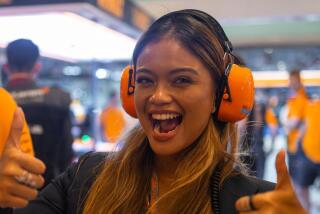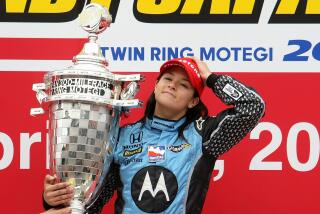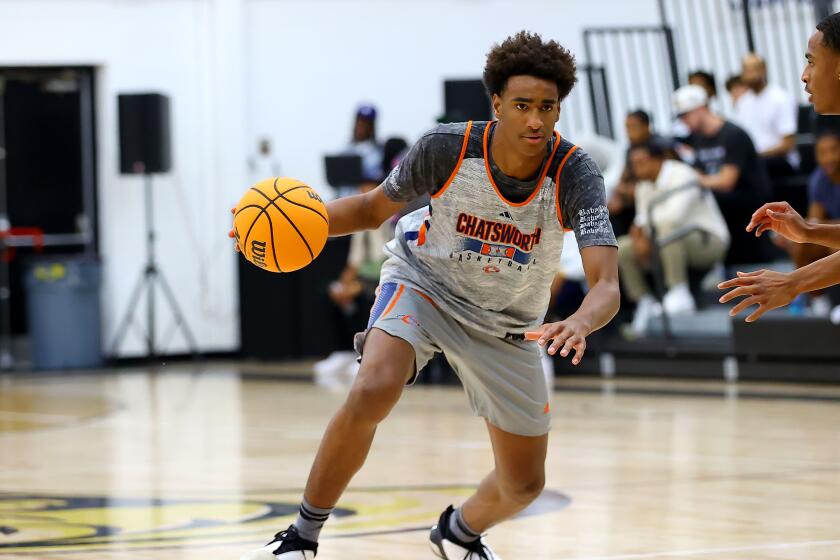The reason why race car driver Danica Patrick doesn’t drink — or eat sugar
- Share via
Pro race car driver Danica Patrick is accustomed to the euphoria that comes with a triumphant spin around the track. As one of the sport’s highest-profile members, she has raced on speedways around the country, including Talladega and Daytona.
But a couple of years ago, Patrick’s post-race celebration was upended by a nauseating headache that seemed to come out of nowhere. All she could do was lay on the couch with her eyes closed; the pain persisted till the next day.
The condition was diagnosed as a migraine, making Patrick, 35, one of a reported 38 million people in the U.S. to suffer from the often-debilitating condition. Luckily, she doesn’t experience the visual disturbances that often accompany migraines.
“Most people don’t realize that migraines are different from a regular headache so it’s hard for them to have sympathy,” said Patrick, who lives in North Carolina. “Even when I first got them, I thought, ‘It’s a headache, get over it.’” (Patrick recently teamed with pain reliever Excedrin, which is rolling out virtual reality videos to underscore how the sudden onset of blurred or tunnel vision can impede a workday: The campaign addresses misunderstandings in the workplace around migraines; people assuming that their co-worker is hung over, for example, or jobs being jeopardized because of them.)
Patrick has since become attuned to what triggers migraines for her — they are different for everyone and can include stress, caffeine or alcohol, or foods that contain nitrates or MSG — and shares some of her tips here:
What has been your experience with migraines?
I’m lucky, in a way, because I’m usually at home when I get them. They happen a day after a race. One of the triggers is a rise or fall in adrenaline, and for me the common denominator was the adrenaline coming down after a race. I haven’t had one in a while because I manage the triggers.
How do you do that?
It’s hard to identify everything. Alcohol sometimes brings them on, so for me it helps to not drink at all. I used to drink beverages with artificial sugars to stay hydrated, which was a bad idea. Now I stay away from them completely.
What are your eating habits like?
I’m very into eating well. I believe food is medicine. I eat extremely clean, real foods. I like foods with one ingredient — an apple, an egg, some spinach. I don’t eat processed foods and never add sugar to anything.
What do you do to stay super fit?
I work out a lot. I have a gym at home. In addition, I do CrossFit to add in cardio and plyometric body weight movements for strength. I do yoga for flexibility and the mind, and I walk my two dogs a lot. My mantra for working out is that it should be uncomfortable. You need to sweat, even if you’re working hard for a short amount of time. If it doesn’t challenge you, it won’t change you.
And you’ve put all these tips into a new book?
It’s called “Pretty Intense” and it comes out in January next year. It’s a 360-degree perspective of health with a 12-week workout program which includes 50 recipes. I photographed the food myself. I’ve tried so many things to stay in shape and I got to this place and wanted to share it.
READ ON!
Yes, you can eat your way to beautiful skin
10 high-tech gadgets to help you get to sleep
How ‘Scandal’s’ Katie Lowes hid her psoriasis
7 steps to making your health your No. 1 priority
He lost 84 pounds in four months — and kept it off
More to Read
Go beyond the scoreboard
Get the latest on L.A.'s teams in the daily Sports Report newsletter.
You may occasionally receive promotional content from the Los Angeles Times.










